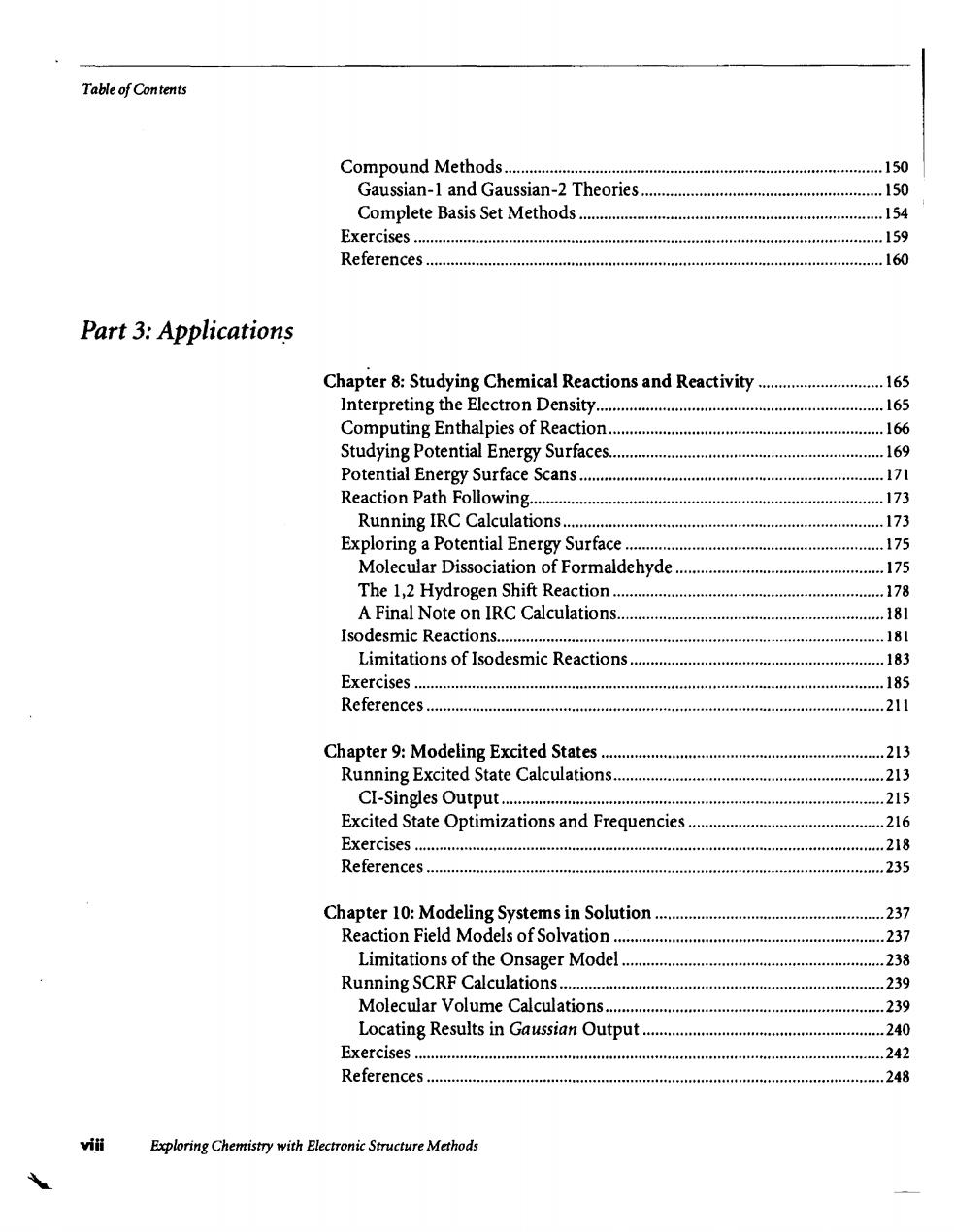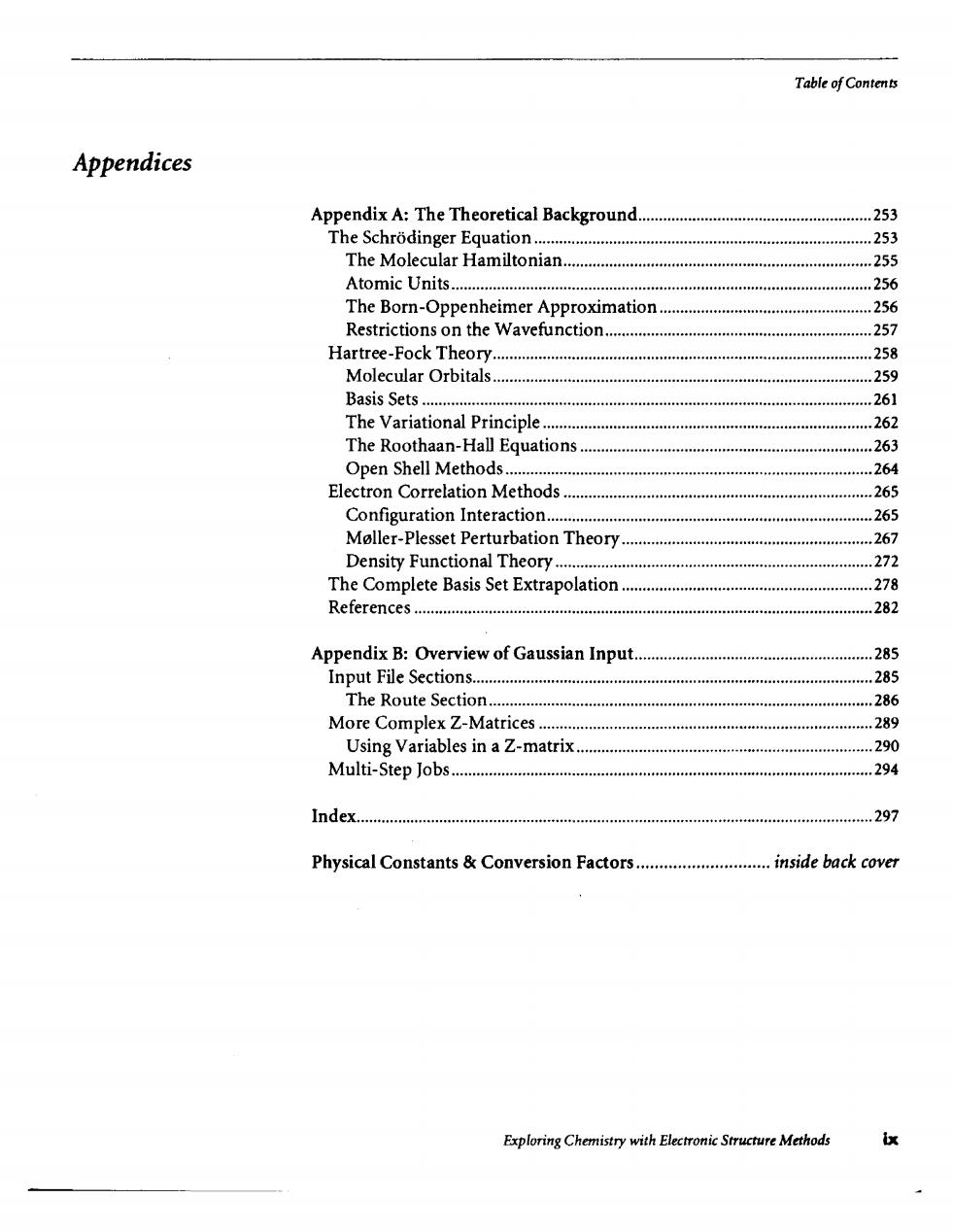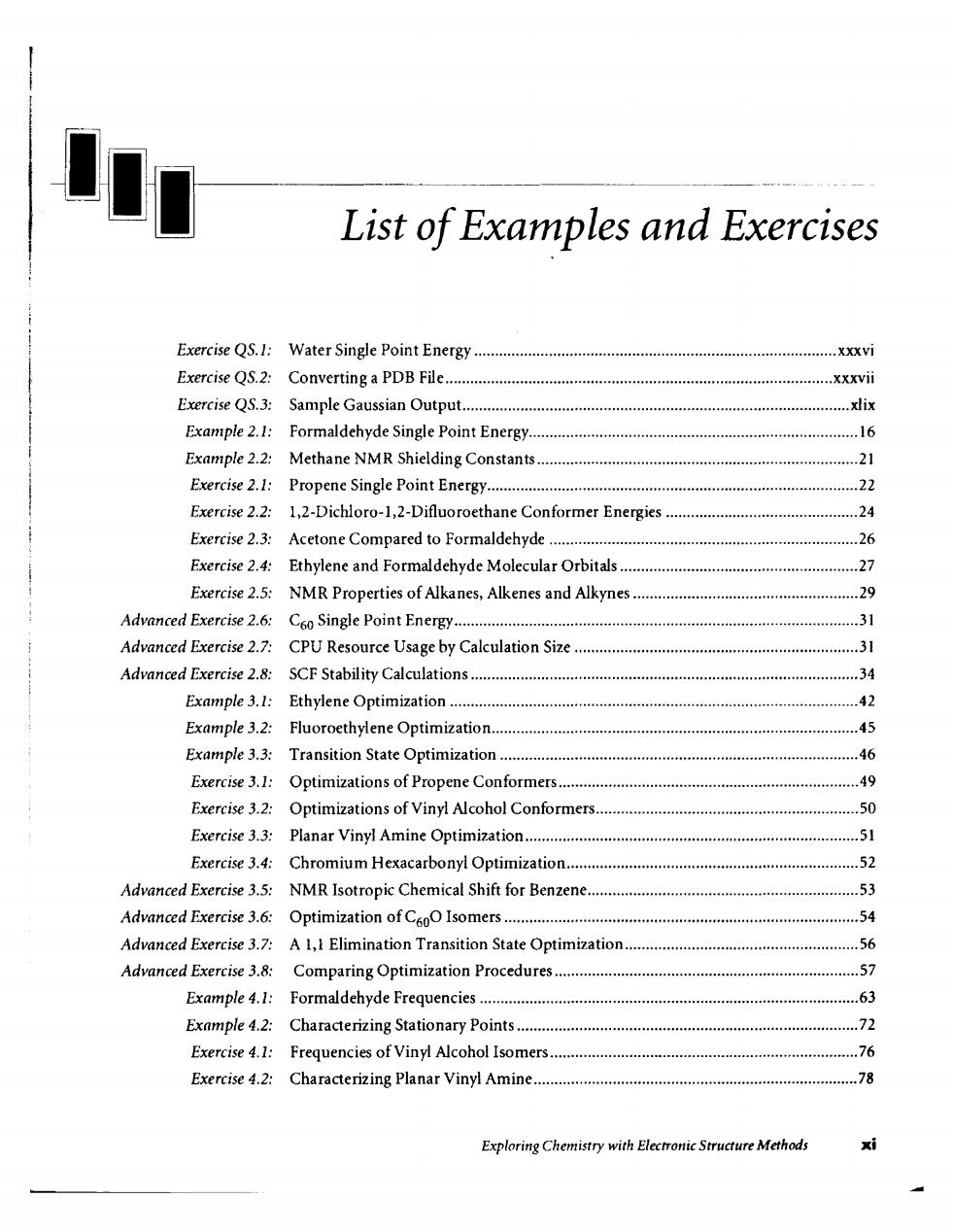
Table of Contents Compound Methods............... .150 Gaussian-1 and Gaussian-2 Theories .150 Complete Basis Set Methods 154 Exercises .159 References.… .160 Part 3:Applications Chapter 8:Studying Chemical Reactions and Reactivity .....165 Interpreting the Blectron Density...165 Computing Enthalpies of Reaction..166 Studying Potential Energy Surfaces......... .169 Potential Energy Surface Scans...171 Reaction Path Following............. .173 Running IRC Calculations................ .173 Exploring a Potential Energy Surface....... .175 Molecular Dissociation of Formaldehyde.................................175 The 1,2 Hydrogen Shift Reaction............ .178 A Final Note on IRC Calculations............. ,181 Isodesmic Reactions.............. 181 Limitations of Isodesmic Reactions.183 Exercises... …185 References.… .211 Chapter 9:Modeling Excited States .213 Running Excited State Calculations................. .213 CI-Singles Output...... .215 Excited State Optimizations and Frequencies................ …216 Bxercises. …218 References… …235 Chapter 10:Modeling Systems in Solution... 237 Reaction Field Models of Solvation....237 Limitations of the Onsager Model....... 238 Running SCRF Calculations........... 239 Molecular Volume Calculations.... 239 Locating Results in Gaussian Output 240 Exercises… .242 References… .248 viii Exploring Chemistry with Electronic Structure Methods
Table ofCon tents Compound Methods 150 Gaussian-l and Gaussian-2 Theories 150 Complete Basis Set Methods 154 Exercises 159 References 160 Part 3: Application.s Chapter 8: Studying Chemical Reactions and Reactivity 165 Interpreting the Electron Density 165 Computing Enthalpies of Reaction 166 Studying Potential Energy Surfaces 169 Potential Energy Surface Scans 171 Reaction Path Following 173 Running IRC Calculations 173 Exploring a Potential Energy Surface 175 Molecular Dissociation of Formaldehyde 175 The 1,2 Hydrogen Shift Reaction 178 A Final Note on IRC Calculations 181 Isodesmic Reactions 181 Limitations of Isodesmic Reactions 183 Exercises 0 185 References 211 Chapter 9: Modeling Excited States 213 Running Excited State Calculations 213 CI-Singles Output 215 Excited State Optimizations and Frequencies 216 Exercises 218 References 235 Chapter 10: Modeling Systems in Solution 237 Reaction Field Models ofSolvation 237 Limitations ofthe Onsager Model 238 Running SCRF Calculations 239 Molecular Volume Calculations 239 Locating Results in Gaussian Output 240 Exercises 242 References 248 viii Exploring Chemistry with Electronic Structure Methods

Table of Contents Appendices Appendix A:The Theoretical Background......53 The Schrodinger Equation...253 The Molecular Hamitonian..55 Atomic Units258 The Born-Oppenheimer Approximation.256 Restrictions on the Wavefunction.57 Hartree-.Fock Theory.… .258 Molecular Orbitals259 Basis Sets............ .261 The Variational Principle....262 The Roothaan-Hall Equations........ .263 Open Shell Methods264 Electron Correlation Methods .265 Configuration Interaction......265 Moller-Plesset Perturbation Theory...... .267 Density Functional Theory .272 The Complete Basis Set Extrapolation... 278 Refetence282 Appendix B:Overview of Gaussian Input.............................................85 Input File Sections........... .285 The Route Section.... 286 More Complex Z-Matrices......... …289 Using Variables in a Z-matrix. …290 Multi-Step Jobs… .294 ndeX.… .297 Physical Constants Conversion Factors....... inside back cover Exploring Chemistry with Electronic Structure Methods
Appendices Table ofCon tents Appendix A: The Theoretical Background 253 The Schrodinger Equation 253 The Molecular Hamiltonian 255 Atomic Units 256 The Born-Oppenheimer Approximation 256 Restrictions on the Wavefunction 257 Hartree-Fock Theory 258 Molecular Orbitals 259 Basis Sets 261 The Variational Principle 262 The Roothaan-Hall Equations 263 Open Shell Methods 264 Electron Correlation Methods 265 Configuration Interaction 265 M011er-Plesset Perturbation Theory 267 Density Functional Theory 272 The Complete Basis Set Extrapolation 278 References 282 Appendix B: Overview of Gaussian Input.. 285 Input File Sections 285 The Route Section 286 More Complex Z-Matrices 289 Using Variables in a Z-matrix 290 Multi-Step Jobs 294 Index 297 Physical Constants & Conversion Factors inside back cover Exploring Chemistry with Electronic Structure Methods Ix

List of Examples and Exercises Exercise QS.1:Water Single point Energy. ...............xxxvi Exercise Q82:Converting a PDB File.......xxvii Exercise Qs.3:Sample Gaussian Output.. ...iX Example 2.1:Formaldehyde Single point Energy..16 Example 2.2:Methane NMR Shielding Constants....21 Exercise 2.1:Propene Single Point Energy.... 22 Exercise 2.2:1,2-Dichioro-1,2-Difluoroethane Conformer Energies 24 Exercise 2.3:Acetone Compared to Formaldehyde ......... .26 Exercise 2.4:Ethylene and Formaldehyde Molecular Orbitals.... 27 Exercise 2.5:NMR Properties of Alkanes,Alkenes and Alkynes....... 429 Advanced Exercise 2.6:C6o Single Point Energy........... 31 Advanced Exercise 2.7:CPU Resource Usage by Calculation Size....... .31 Advanced Exercise 2.8:SCF Stability Calculations........................... 34 Example 3.1:Ethylene Optimization ............... …42 Example 3.2:Fluoroethylene Optimization........ 45 Example 3.3:Transition State Optimization........... …46 Exercise 3.1:Optimizations of Propene Conformers.. 49 Exercise 3.2:Optimizations of Vinyl Alcohol Conformers....... 50 Exercise 3.3:Planar Vinyl Amine Optimization.5. Exercise 3.4:Chromium Hexacarbonyl Optimization...... 52 Advanced Exercise 3.5:NMR Isotropic Chemical Shift for Benzene...53 Advanced Exercise 3.6:Optimization of C00 Isomers.................. 54 Advanced Exercise 3.7:A 1,1 Elimination Transition State Optimization...... .56 Advanced Exercise 3.8:Comparing Optimization Procedures...... .57 Example 4.1:Formaldehyde Frequencies...63 Example 4.2:Characterizing Stationary Points................. 72 Exercise 4.1:Frequencies of Vinyl Alcohol Isomers............. .76 Exercise 4.2:Characterizing Planar Vinyl Amine.78 Exploring Chemistry with Electronic Structure Methods xi
III~-·~ List ofExamples and Exercises Exercise QS.1: Exercise QS.2: Exercise QS.3: Example 2.1: Example 2.2: Exercise 2.1: Exercise 2.2: Exercise 2.3: Exercise 2.4: Exercise 2.5: Advanced Exercise 2.6: Advanced Exercise 2.7: Advanced Exercise 2.8: Example 3.1: Example 3.2: Example 3.3: Exercise 3.1: Exercise 3.2: Exercise 3.3: Exercise 3.4: Advanced Exercise 3.5: Advanced Exercise 3.6: Advanced Exercise 3.7: Advanced Exercise 3.8: Example 4.1: Example 4.2: Exercise 4.1: Exercise 4.2: Water Single Point Energy xxxvi Converting a PDB File xxxvii Sample Gaussian Output xJix Formaldehyde Single Point Energy 16 Methane NMR Shielding Constants 21 Propene Single Point Energy 22 1,2-Dichloro-l ,2-Difluoroethane Conformer Energies 24 Acetone Compared to Formaldehyde 26 Ethylene and Formaldehyde Molecular Orbitals 27 NMR Properties of Alkanes, Alkenes and Alkynes 29 C60 Single Point Energy 31 CPU Resource Usage by Calculation Size 31 SCF Stability Calculations 34 Ethylene Optimization 42 Fluoroethylene Optimization 45 Transition State Optimization 46 Optimizations of Propene Conformers 49 Optimizations of Vinyl Alcohol Conformers 50 Planar Vinyl Amine Optimization 51 Chromium Hexacarbonyl Optimization 52 NMR Isotropic Chemical Shift for Benzene 53 Optimization ofC600 Isomers 54 A 1,1 Elimination Transition State Optimization 56 Comparing Optimization Procedures 57 Formaldehyde Frequencies 63 Characterizing Stationary Points 72 Frequencies ofVinyl Alcohol Isomers 76 Characterizing Planar Vinyl Amine 78 Exploring Chemistry with Electronic Structure Methods xi

List of Examples and Exercises Exercise 4.3:Vinyl Series Frequencies................. .80 Exercise 4.4:Carbonyl Stretch by Substituent......... 4.84 Advanced Exercise 4.5:Strained Hydrocarbons.. 86 Advanced Exercise 4.6:A 1,3 Hydrogen Shift on the C3HsF Potential Energy Surface.............................89 Example 5.1:Methanol vs.Methoxide Anion Optimizations ......... .100 Example 5.2:PO Bond Distance.... …101 Exercise 5.1:HE Bond Length........ …103 Exercise 5.2:Periodic Trends in Transition Metal Complexes... .104 Advanced Exercise 5.3:Basis Set Effects on NMR Calculations(Benzene) .104 Advanced Exercise 5.4:Geometry of N,N-Dimethylformamide............. …105 Advanced Exercise 5.5:Basis Set Definitions............. .107 Advanced Exercise 5.6:Comparing 6-31G(d)and 6-31Gt....... .109 Example 6.1:TPP Molecular Orbitals................... 112 Example 6.2:HE Dimer.... .113 Example 6.3:HF Bond Energy.... .115 Example 6.4 Optimization of Ozone....118 Example 6.5:CO Structure and Atomization Energy........... .119 Example 6.6:F Structure and Frequencies................. .121 Exercise 6.1:Butane-Iso-Butane Isomerization Energy124 Exercise 6.2:Rotational Barrier of N-Butane125 Exercise 6.3:Malonaldehyde Optimization ............... .126 Exercise 6.4: Optimization ofEOOF 128 Exercise 6.5:Acetaldehyde-Ethylene Oxide Isomerization Energy.................129 Advanced Exercise 6.6:Spin Polarization in Heterosubstituted Allyl Radicals.. 130 Advanced Exercise 6.7:M+F3 Structures and Frequencies............... .133 Advanced Exercise 6.8:Hyperfine Coupling Constants...... .136 Advanced Exercise 6.9:Ozone Destruction by Atomic Chlorine. 137 Example 7.1:Atomization Energy of PH2............. .141 Example 7.2:Electron Affinity of PH2.............. .142 Example 7.3:Ionization Potential of PH2. .143 Example 7.4:Proton Affinity of PH3............ …143 Example 75:G2Proton Affinity ofPH3....153 Example 7.6:CBS-4 and CBS-Q Proton Affinities of PH3............ 156 Exercise 7.1:CBS-4 Thermochemistry............. 159 Advanced Exercise 7.2:Ozone Destruction by Atomic Chlorine Revisited....159 xi Exploring Chemistry with Electronic Structure Methods
List ofExamples and Exercises Exercise 4.3: Vinyl Series Frequencies 80 Exercise 4.4: Carbonyl Stretch by Substituent 84 Advanced Exercise 4.5: Strained Hydrocarbons 86 Advanced Exercise 4.6: A 1,3 Hydrogen Shift on the C3HsF Potential Energy Surface _ 89 Example 5.1: Methanol vs. Methoxide Anion Optimizations 100 Example 5.2: PO Bond Distance 101 Exercise 5.1: HF Bond Length 103 Exercise 5.2: Periodic Trends in Transition Metal Complexes 104 Advanced Exercise 5.3: Basis Set Effects on NMR Calculations (Benzene) 104 Advanced Exercise 5.4: Geometry ofN,N-Dimethylformamide 105 Advanced Exercise 5.5: Basis Set Definitions 107 Advanced Exercise 5.6: Comparing 6-31G(d) and 6-31Gt 109 Example 6.1: TPP Molecular Orbitals 112 Exanlple 6.2: HF Dimer 113 Example 6.3: HF Bond Energy 115 Exanlple 6.4: Optimization of Ozone 118 Example 6.5: CO2 Structure and Atomization Energy 119 Example 6.6: F3- Structure and Frequencies 121 Exercise 6.1: Butane-Iso-Butane Isomerization Energy 124 Exercise 6.2: Rotational Barrier of N-Butane 125 Exercise 6.3: Malonaldehyde Optimization 126 Exercise 6.4: Optimization of FOOF 128 Exercise 6.5: Acetaldehyde-Ethylene Oxide Isomerization Energy 129 Advanced Exercise 6.6: Spin Polarization in Heterosubstituted Allyl Radicals 130 Advanced Exercise 6.7: M+F3- Structures and Frequencies 133 Advanced Exercise 6.8: Hyperfine Coupling Constants 136 Advanced Exercise 6.9: Ozone Destruction by Atomic Chlorine 137 Example 7.1: Atomization Energy of PH2 141 Exanlple 7.2: Electron Affinity of PH2 142 Example 7.3: Ionization Potential of PH2 143 Example 7.4: Proton Affinity ofPH3 143 Example 7.5: G2 Proton Affinity of PH3 153 Example 7.6: CBS-4 and CBS-Q Proton Affinities ofPH3 156 Exercise 7.1: CBS-4 Thermochemistry 159 Advanced Exercise 7.2: Ozone Destruction by Atomic Chlorine Revisited 159 • xii Exploring Chemistry with Electronic Structure Methods

List of Examples and Exercises Example 8.1:Electron Densities of Substituted Benzenes....165 Example 8.2:Hydration Reactions166 Example 8.3:CH2OH2+CO IRC... …176 Example 8.4:CHOHCOH IRC.......... …179 Example 8.5:AH for an Isodesmic Reaction.............. …182 Example 8.6:Predicting the Heat of Formation of CO via an Isodesmic Reaction.................182 Example 8.7:Limitations of Isodesmic Reactions............. .183 Exercise 8.1:Hydration Reactions..... .185 Exercise 8.2:Bond Dissociation... 186 Exercise 8.3:HCO Potential Energy Surface.191 Exercise 8.4:Atomic Charge Analysis.. 4…194 Exercise 8.5:Group Charges....... …197 Advanced Exercise 8.6:Atoms in Molecules Charges and Bond Orders.... …198 Advanced Exercise 8.7:Si+Silane Potential Energy Surface......... 199 Advanced Exercise 8.8:Isodesmic Reactions....................... …204 Advanced Exercise 8.9:Heats of Formation via Isodesmic Reactions....... …206 Advanced Exercise 8.10:An SN2 Reaction.... .208 Example 9.1:Ethylene Excited States................. .214 Example 9.2:Formaldehyde Excited State Optimization.... .216 Exercise 9.1:Methylenecyclopropene Excited States............... .218 Exercise 9.2:Formaldehyde Excited State Optimization.220 Exercise 9.3:Acrolein Excited State Optimization.223 Advanced Exercise 9.4:Benzene Excitation Energies........................ 224 Advanced Exercise 9.5:Using the CASSCF Method to Study Excited State Systems.................. …228 Advanced Exercise 9.6:Using CASSCF to Study Butadiene Photochemistry............2.32 Example 10.1:Dichloroethane Conformer Energy Difference by Solvent...... …239 Example 10.2:Formaldehyde Frequencies in Acetonitrile................. .241 Exercise 10.1:Dichloroethane Conformer Energy Differences ........ .242 Exercise 10.2:Formaldehyde Frequencies..244 Exercise 10.3:Carbonyl Stretch in Solution............... 244 Advanced Exercise 10.4:Rotational Barrier in Solution for N-Methyl-2-Nitrovinylamine...........................246 Advanced Exercise 10.5:Comparing SCRF Methods on Furfuraldehyde.................. 247 Example A.1:Comparing Integration Grids..276 Exercise B.1:Z-Matrices for 1,2-Dichloro-1,2-Difluoroethane Isomers.................291 Exercise B.2:Mixed Cartesian and Internal Coordinates.........293 Exploring Chemistry with Electronic Structure Methods 湖
List ofExamples and EuTci5es Example 8.1: Electron Densities of Substituted Benzenes 165 Example 8.2: Hydration Reactions 166 Example 8.3: CH20 -t H2+CO IRC 176 Example 8.4: CH20 -t HCOH IRC 179 Example 8.5: dH for an Isodesmic Reaction 182 Example 8.6: Predicting the Heat of Formation ofC02 via an Isodesmic Reaction 182 Example 8.7: Limitations ofIsodesmic Reactions 183 Exercise 8.1: Hydration Reactions 185 Exercise 8.2: Bond Dissociation 186 Exercise 8.3: H2CO Potential Energy Surface 191 Exercise 8.4: Atomic Charge Analysis 194 Exercise 8.5: Group Charges 197 Advanced Exercise 8.6: Atoms in Molecules Charges and Bond Orders 198 Advanced Exercise 8.7: Si+ +Silane Potential Energy Surface 199 Advanced Exercise 8.8: Isodesmic Reactions 204 Advanced Exercise 8.9: Heats ofFormation via Isodesmic Reactions 206 Advanced Exercise 8.10: An SN2 Reaction 208 Example 9.1: Ethylene Excited States 214 Example 9.2: Formaldehyde Excited State Optimization 216 Exercise 9.1: Methylenecyclopropene Excited States 218 Exercise 9.2: Formaldehyde Excited State Optimization 220 Exercise 9.3: Acrolein Excited State Optimization 223 Advanced Exercise 9.4: Benzene Excitation Energies 224 Advanced Exercise 9.5: Using the CASSCF Method to Study Excited State Systems 228 Advanced Exercise 9.6: Using CASSCF to Study Butadiene Photochemistry 232 Example 10.1: Dichloroethane Conformer Energy Difference by Solvent 239 Example 10.2: Formaldehyde Frequencies in AcetonitriIe 241 Exercise 10.1: Dichloroethane Conformer Energy Differences 242 Exercise 10.2: Formaldehyde Frequencies 244 Exercise 10.3: Carbonyl Stretch in Solution 244 Advanced Exercise 10.4: Rotational Barrier in Solution for N-Methyl-2-Nitrovinylamine 246 Advanced Exercise 10.5: Comparing SCRF Methods on Furfuraldehyde 247 Example A.I: Comparing Integration Grids 276 Exercise B.1: Z-Matrices for 1,2-Dichloro-l,2-Difluoroethane Isomers 291 Exercise B.2: Mixed Cartesian and Internal Coordinates 293 Exploring Chemistry with Electronic Structure Methods